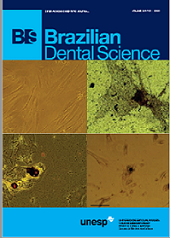Association of Khat chewing, smoking, age and sex with periodontal status among Yemeni adults
DOI:
https://doi.org/10.14295/bds.2020.v23i1.1861Resumo
Objective: Periodontal diseases are very common dental disease. Many risk factors may play significant role in the periodontal disease initiation and progression. This study was performed to evaluate the effects of khat chewing, smoking, age and gender on periodontal status among Yemeni adults. Material and Methods: This cross-sectional study was performed on 1231 patients attending the outpatient dental polyclinics of University of Science and Technology during the academic years 2017/2018.. All completed sheets were collected throughout the year by the supervisors. Data cleaning, descriptive statistics, and inferential statistics were then performed. Results: Khat chewers were more frequent than non-chewers counterparts (60.7% vs. 39.3%). The prevalence of smoking was 25.5% (297 patients). Study results indicated that periodontitis is more associated with female gender and participants aged more than 35 years old. Results also showed that female and age older participants aged more than 35 years were significantly associated with gingival recession. Mean number of the teeth with gingival recession in male patients were higher than in females. Male gender and patients aged more than 35 years old were significantly associated with furcation involvement. Conclusion: The present study has shown females gender and age older than 35 seem to be risk factors of periodontal diseases. Males has more teeth affected by gingival recession and more furcation involvement.
Keywords
Periodontal disease; Khat chewing; Smoking; Yemen; Risk factors.
Downloads
Downloads
Publicado
Como Citar
Edição
Seção
Licença
TRANSFERÊNCIA DE DIREITOS AUTORAIS E DECLARAÇÃO DE RESPONSABILIDADE
Toda a propriedade de direitos autorais do artigo "____________________________________________________________________" é transferido do autor(es) para a CIÊNCIA ODONTOLÓGICA BRASILEIRA, no caso do trabalho ser publicado. O artigo não foi publicado em outro lugar e não foi submetido simultaneamente para publicação em outra revista.
Vimos por meio deste, atestar que trabalho é original e não apresenta dados manipulados, fraude ou plágio. Fizemos contribuição científica significativa para o estudo e estamos cientes dos dados apresentados e de acordo com a versão final do artigo. Assumimos total responsabilidade pelos aspectos éticos do estudo.
Este texto deve ser impresso e assinado por todos os autores. A versão digitalizada deverá ser apresentada como arquivo suplementar durante o processo de submissão.




























